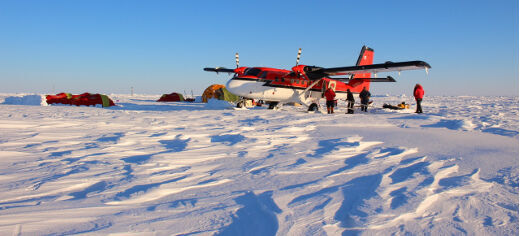
The volume of Arctic sea ice increased by a third after the summer of 2013 as unusually cool air temperatures prevented the ice from melting, according to University of Leeds and UCL scientists.
This suggests that the ice pack in the Northern Hemisphere is more sensitive to changes in summer melting than it is to winter cooling, a finding which will help researchers predict future changes in its volume.
The study, published today in Nature Geoscience, used 88 million measurements of sea ice thickness recorded by the European Space Agency’s CryoSat-2 satellite between 2010 and 2014. It showed that there was a 14% reduction in the volume of summertime Arctic sea ice between 2010 and 2012, but the volume of ice jumped by 41% in 2013, when the summer was 5% cooler than the previous year.
Study co-author Professor Andy Shepherd, from the School of Earth and Environment at the University of Leeds and Director of the Centre for Polar Observation and Modelling (CPOM), said: “Understanding what controls the amount of Arctic sea ice takes us one step closer to making reliable predictions of how long it will last, which is important because it is a key component of Earth’s climate system.”
Lead author and PhD student Rachel Tilling, from UCL Earth & Planetary Sciences, who is a member of the CPOM team, said: “The summer of 2013 was much cooler than recent years with temperatures typical of those seen in the late 1990s. This allowed thick sea ice to persist north-west of Greenland because there were fewer days when it could melt. Although models have suggested that the volume of Arctic sea ice is in long term decline, we know now that it can recover by a significant amount if the melting season is cut short.”
The volume of Arctic ice has been steadily falling since the late 1970s but was difficult to assess accurately before CryoSat-2, which measures ice-thickness across the whole region.
Tilling added: “Until CryoSat-2 was launched, it was tricky to measure the volume of Arctic sea ice as the pack drifts and measurements could not be taken across the whole region. Together with maps of sea ice extent, our measurements of sea ice thickness now complete the picture because they reveal what’s going on below the water, where most of the action happens.”
Although the first five years of CryoSat-2 measurements have revealed important information on the state of Arctic sea ice, the record is still short to establish a long-term trend.
Professor Shepherd said: “Although the jump in volume means that the Arctic is unlikely to be ice-free this summer, we still expect temperatures to rise in the future, and so the events of 2013 will have simply wound the clock back a few years on the long-term pattern of decline. Our goal is to make sure we do not lose this unique capability to monitor sea ice when the mission ends.”
The team now plan to use CryoSat-2’s measurements of changing sea ice thickness to help improve the models that are used to predict future climate change, and also to assist maritime activities in the Arctic region, which can be dangerous and costly to navigate.
Further information
The research was funded by the Natural Environment Research Council (NERC).
Professor Andy Shepherd is available for interview. Please contact Sarah Reed, Press Officer at the University of Leeds, on 0113 34 34196 or email s.j.reed@leeds.ac.uk.
The research paper 'Increased Arctic sea ice volume after anomalously low melting in 2013' is published in the journal Nature Geoscience on 20 July 2015.
Image caption: Setting up camp on sea ice in the Lincoln Sea, north of Greenland, in March 2014 as part of the ESA CryoVex experiment to measure sea ice properties including the depth of drifting snow.
Credit: Rachel Tilling